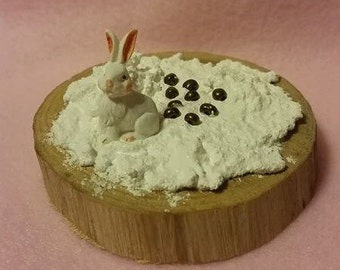
Aged males that have been usurped by younger, fitter rabbits are driven from the group to become solitary satellite males ( Lockley, 1978). Male rabbits within the group will establish a dominance hierarchy, with the older heavier males at the top. The group’s territory is defended by the males, while the females dig out deep burrows to nest in.
#Tiny bunny poop plus#
Wild rabbits live in groups of two to eight adults plus juveniles with a defined social hierarchy ( McBride, 1988). The home range is rarely larger than 20 hectares ( Nowak, 1999). Oryctolagus cuniculus is essentially nocturnal, leaving the burrow in the early evening and returning in the morning, although it can be seen grazing or basking during the day. The main surface entrances are usually indicated by mounds of earth but there are numerous other small openings that lack these mounds. The tunnels are about 15 cm in diameter and the living chambers 30–60 cm high. It often digs complex burrows or warrens that can be 3 m deep and 45 m long. The European rabbit, Oryctolagus cuniculus, prefers a sandy, hilly terrain with shrubs and woody plants and is not found at altitudes above 600 m. Cottontails are solitary animals, in contrast with Oryctolagus cuniculus, which live in groups with a defined social hierarchy ( Nowak, 1999). Vegetation is used to cover the fur-lined nest between feeds.

Females dig holes to make nests and sit over the hole to suckle the young. For example, cottontails (Sylvilagus spp.) do not dig burrows, although they may use burrows made by other animals. The behavioural characteristics of lagomorphs differ between species. All members of the Lagomorpha order are terrestrial and eat only vegetation. Other lagomorphs include hares and pikas.

Current opinion suggests that Rodentia and Lagomorpha have no fundamental similarities and on the basis of structural features and serological data, Lagomorpha show more affinity to Artiodactyla (hoofed mammals) ( Nowak, 1999). Lagomorphs were once considered to be a suborder of the Rodentia, which is divided into Sciuromorpha (squirrel-like rodents), Myomorpha (mouse-like rodents) and Hystricomorpha (porcupine-like rodents) that includes guinea pigs and chinchillas. Rabbits belong to the order Lagomorpha, which are characterized by the presence of a second small pair of upper incisors or peg teeth situated behind the central incisors. The modern pet rabbit still retains many of the characteristics of its wild counterparts despite changes in size, colour, coat texture and temperament. The Romans brought many food animals with them, such as pheasant and quail, and it is believed that they not only introduced rabbits but also kept them in cages, thereby starting the process of domestication. It is not clear when the European rabbit was introduced into Great Britain. The North American jackrabbit, Lepus californicus, is from the hare genus. In North America the native wild rabbit is either Sylvilagus floridanus (cottontail) or Sylvilagus bachmani (brush rabbit).

Although European rabbits have been released in North America, the presence of suitable predators, an unsuitable climate and other species filling their ecological niche proved insurmountable. More recently rabbits were introduced in Victoria, Australia, where their success, due to rapid breeding and a lack of suitable predators, rapidly became a plague that cost the Australian Government millions of dollars and led to the implementation of myxomatosis virus for biological control. Thus their European range significantly altered, and rabbits proved very successful where the climate and geographical conditions were suitable. The geographical range of the rabbit has been altered significantly by man, who from Roman times onwards placed rabbits on islands on various shipping routes, to allow them to breed and form a ready source of food. While rabbits have been associated with man since Roman times, they have only been truly domesticated for around 200 years. Fossil records show that the European rabbit was confined to the Iberian peninsula and southern France following the Pleistocene era. The ancestral form probably evolved in the Iberian Peninsula and spread to other parts of the Mediterranean ( Fox, 1974). Domestic rabbits are descended from the European rabbit, Oryctolagus cuniculus.


 0 kommentar(er)
0 kommentar(er)
